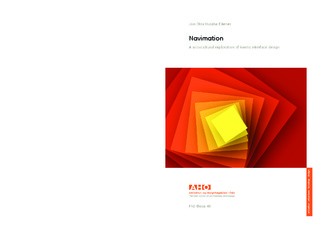Navimation : a sociocultural exploration of kinetic interface design
Book, Doctoral thesis, Academic article

Åpne
Permanent lenke
http://hdl.handle.net/11250/93030Utgivelsesdato
2010Metadata
Vis full innførselSamlinger
- Design [33]
Originalversjon
Eikenes, Jon Olav. (2010). Navimation: a sociocultural exploration of kinetic interface design. [Oslo]: Arkitektur- og designhøgskolen i Oslo.Sammendrag
Digitale produkt er ein stadig viktigare del av kulturen vår og er knytte til aktivitetar i arbeid, leik og fritid. Mange av desse aktivitetane skjer gjennom skjermbaserte grensesnitt, som dermed spelar ei viktig rolle i å aktivere og engasjere folk i deira daglege liv. Skjermbasert, visuell bevegelse er eit stadig meir framståande kjenneteikn ved mobiltelefonar, dataspel, operativsystem og nettsider. Denne avhandlinga presenterer ’kinetiske grensesnitt’ som eit sentralt omgrep for å analysere skjermbaserte digitale produkt som er prega av visuell bevegelse. Av fleire konsept som er innførde for å forstå kinetiske grensesnitt, refererer ’navimasjon’ til navigasjonshandlingar som er knytte saman med bevegelse. Skjermbaserte grensesnitt er konstruerte produkt, og må utformast av nokon. Design av grensesnitt spelar ei viktig rolle i å forme meiningar og aktivitetar som vert mogelege via digitale produkt. Det er underskot på designforsking og litteratur som tek føre seg kjenneteikna til kinetiske grensesnitt. Korleis kan vi forstå bruk av bevegelse i kinetiske grensesnitt, og kva er kjenneteikna og det kommunikative potensialet til slike grensesnitt? Korleis kan vi undersøke eit slikt fenomen som kontinuerleg er under utvikling, i og gjennom design? For å forstå desse nye mogelegheitene er det behov for studiar som fokuserer på det kinetiske grensesnittet som ein medierande og kulturell gjenstand i seg sjølv, og erkjenner at desse er situerte i sosiale og kulturelle kontekstar. Denne avhandlinga inneheld tre publiserte forskingstekstar, derav to rapporterer om mine eigne designeksperiment som er utført saman med ulike partnarar innan eit større forskingsprosjekt kalla RECORD. I tillegg er ein metarefleksjon (’kappe’) lagt fram for å plassere og bygge vidare på desse publikasjonane. Ved å nytte ’forsking gjennom design’ kombinerer studien tekstanalyse og tekstkonstruksjon gjennom eksperimentell designproduksjon. Nye analytiske omgrep og konsept er genererte ved å kombinere analyse og design; desse omgrepa er nødvendige både for å forstå og utforme kinetiske grensesnitt.
Avhandlinga tek utgangspunkt i eit sosiokulturelt syn på design og analyse av grensesnitt, og nyttar sosialsemiotikk og omgrep frå aktivitetsteori. Dette synet understrekar verdien av det sosiale og kulturelle i menneskeleg aktivitet og meiningsskaping. Avhandlinga argumenterer for at kinetiske grensesnitt spelar fleire roller i moderne kultur og bruk, gjennom semiotisk mediering og instrumentell mediering. Grensesnitt er meiningsfulle og kulturelle gjenstandar som nyttar teikn eller semiotiske ressursar for å kommunisere gjennom utforming og bruk. Samtidig gjer dei det mogeleg å utføre aktivitetar og handlingar gjennom instrumentell mediering, på ein måte som liknar verktøy eller instrument. Eg kallar sambandet mellom desse rollene for dobbel mediering.
Forholdet mellom instrumentell og semiotisk mediering er komplekst, og denne avhandlinga legg fram ein ny modell for å forstå det kinetiske grensesnittet som både verktøy og teikn. Dette synet er komplimentert med ei utgreiing om den dialogiske utvekslinga som skjer mellom brukarar og kinetiske grensesnitt, kalla dialogisk interaksjon. Det viktigaste bidraget til avhandlinga er ei rekke nye omgrep som er innførde for å analysere og konstruere kinetiske grensesnitt, for eksempel for sosiale media og surfing på Internett. Studien gjev kunnskap om kinetiske grensesnitt, og demonstrerer at det er mogeleg å konstruere teori og analytiske konsept ved å kombinere designeksperimentering og analyse.
Beskrivelse
Publication 1 & 3: "Open Access - This article is distributed under the terms of the Creative Commons Attribution Noncommercial License which permits any noncommercial use, distribution, and reproduction in any medium, provided the source is credited."